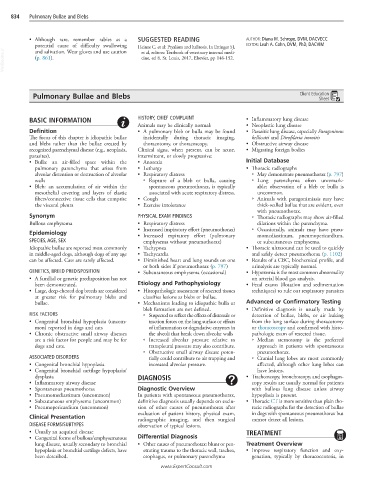Page 1662 - Cote clinical veterinary advisor dogs and cats 4th
P. 1662
834 Pulmonary Bullae and Blebs
• Although rare, remember rabies as a SUGGESTED READING AUTHOR: Diana M. Schropp, DVM, DACVECC
potential cause of difficulty swallowing Heinze C, et al: Ptyalism and halitosis. In Ettinger SJ, EDITOR: Leah A. Cohn, DVM, PhD, DACVIM
VetBooks.ir (p. 861). cine, ed 8, St. Louis, 2017, Elsevier, pp 146-152.
and salivation. Wear gloves and use caution
et al, editors: Textbook of veterinary internal medi-
Pulmonary Bullae and Blebs Client Education
Sheet
BASIC INFORMATION HISTORY, CHIEF COMPLAINT • Inflammatory lung disease
Animals may be clinically normal: • Neoplastic lung disease
Definition • A pulmonary bleb or bulla may be found • Parasitic lung disease, especially Paragonimus
The focus of this chapter is idiopathic bullae incidentally during thoracic imaging, kellicotti and Dirofilaria immitis
and blebs rather than the bullae created by thoracotomy, or thoracoscopy. • Obstructive airway disease
recognized parenchymal disease (e.g., neoplasia, Clinical signs, when present, can be acute, • Migrating foreign bodies
parasites). intermittent, or slowly progressive:
• Bulla: an air-filled space within the • Anorexia Initial Database
pulmonary parenchyma that arises from • Lethargy • Thoracic radiographs
alveolar distention or destruction of alveolar • Respiratory distress ○ May demonstrate pneumothorax (p. 797)
walls ○ Rupture of a bleb or bulla, causing ○ Lung parenchyma often unremark-
• Bleb: an accumulation of air within the spontaneous pneumothorax, is typically able; observation of a bleb or bulla is
mesothelial covering and layers of elastic associated with acute respiratory distress. uncommon.
fibers/connective tissue cells that comprise • Cough ○ Animals with paragonimiasis may have
the visceral pleura • Exercise intolerance thick-walled bullae that are evident, even
with pneumothorax.
Synonym PHYSICAL EXAM FINDINGS ○ Thoracic radiographs may show air-filled
Bullous emphysema • Respiratory distress dilations within the parenchyma.
• Increased inspiratory effort (pneumothorax) ○ Occasionally, animals may have pneu-
Epidemiology • Increased expiratory effort (pulmonary momediastinum, pneumopericardium,
SPECIES, AGE, SEX emphysema without pneumothorax) or subcutaneous emphysema.
Idiopathic bullae are reported most commonly • Tachypnea • Thoracic ultrasound can be used to quickly
in middle-aged dogs, although dogs of any age • Tachycardia and safely detect pneumothorax (p. 1102)
can be affected. Cats are rarely affected. • Diminished heart and lung sounds on one • Results of a CBC, biochemical profile, and
or both sides if pneumothorax (p. 797) urinalysis are typically normal.
GENETICS, BREED PREDISPOSITION • Subcutaneous emphysema (occasional) • Hypoxemia is the most common abnormality
• A familial or genetic predisposition has not on arterial blood gas analysis.
been demonstrated. Etiology and Pathophysiology • Fecal exams (flotation and sedimentation
• Large, deep-chested dog breeds are considered • Histopathologic assessment of resected tissues techniques) to rule out respiratory parasites
at greater risk for pulmonary blebs and classifies lesions as blebs or bullae.
bullae. • Mechanisms leading to idiopathic bulla or Advanced or Confirmatory Testing
bleb formation are not defined. • Definitive diagnosis is usually made by
RISK FACTORS ○ Suspected to reflect the effects of distensile or detection of bullae, blebs, or air leaking
• Congenital bronchial hypoplasia (uncom- traction forces on the lung surface or effects from the lung surface during thoracotomy
mon) reported in dogs and cats of inflammation or degradative enzymes in or thoracoscopy and confirmed with histo-
• Chronic obstructive small airway diseases the alveoli that break down alveolar walls pathologic exam of resected tissue.
are a risk factor for people and may be for ○ Increased alveolar pressure relative to ○ Median sternotomy is the preferred
dogs and cats. transpleural pressure may also contribute. approach in patients with spontaneous
○ Obstructive small airway disease poten- pneumothorax.
ASSOCIATED DISORDERS tially could contribute to air trapping and ○ Cranial lung lobes are most commonly
• Congenital bronchial hypoplasia increased alveolar pressure. affected, although other lung lobes can
• Congenital bronchial cartilage hypoplasia/ have lesions.
dysplasia DIAGNOSIS • Tracheoscopy, bronchoscopy, and esophagos-
• Inflammatory airway disease copy results are usually normal for patients
• Spontaneous pneumothorax Diagnostic Overview with bullous lung disease unless airway
• Pneumomediastinum (uncommon) In patients with spontaneous pneumothorax, hypoplasia is present.
• Subcutaneous emphysema (uncommon) definitive diagnosis usually depends on exclu- • Thoracic CT is more sensitive than plain tho-
• Pneumopericardium (uncommon) sion of other causes of pneumothorax after racic radiographs for the detection of bullae
evaluation of patient history, physical exam, in dogs with spontaneous pneumothorax but
Clinical Presentation radiographic imaging, and then surgical cannot detect all lesions.
DISEASE FORMS/SUBTYPES observation of typical lesions.
• Usually an acquired disease TREATMENT
• Congenital forms of bullous/emphysematous Differential Diagnosis
lung disease, usually secondary to bronchial • Other causes of pneumothorax: blunt or pen- Treatment Overview
hypoplasia or bronchial cartilage defects, have etrating trauma to the thoracic wall, trachea, • Improve respiratory function and oxy-
been described. esophagus, or pulmonary parenchyma genation, typically by thoracocentesis, in
www.ExpertConsult.com

